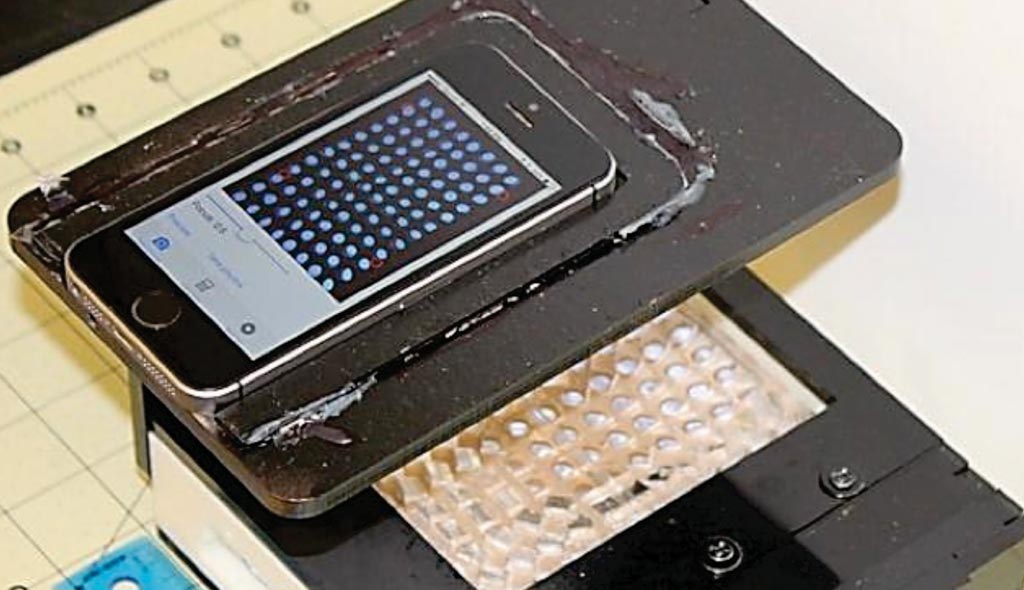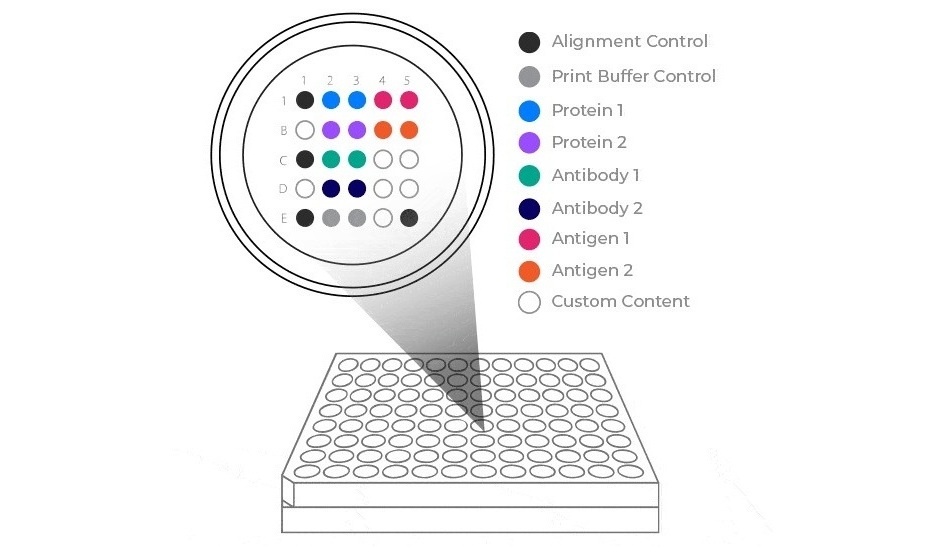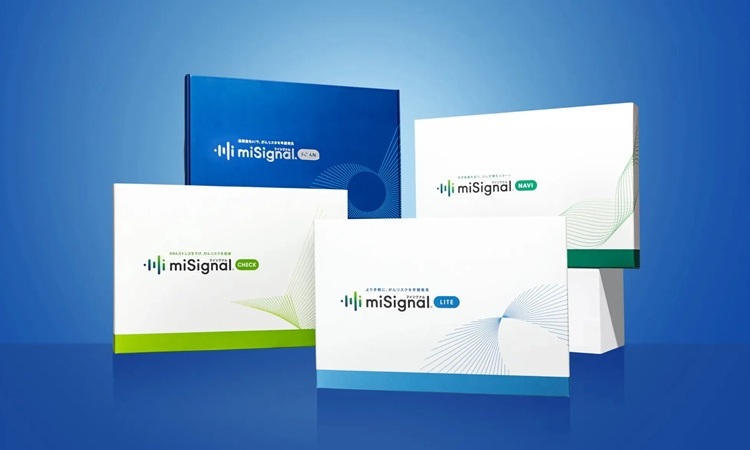Smart Phone Reader Detects Common Pathogens
|
By LabMedica International staff writers Posted on 10 May 2018 |

Image: The low-cost, portable laboratory on a phone that can interpret results from a microplate assay (Photo courtesy of Washington State University).
In rural or low resource areas, doctors sometimes must rely on a patient's symptoms or use their own judgement in looking at test sample color results to determine whether a patient has an infection.
A low-cost, portable laboratory on a phone has been developed that works nearly as well as clinical laboratories to detect common viral and bacterial infections. The work could lead to faster and lower-cost laboratory results for fast-moving viral and bacterial epidemics.
Bioengineers at Washington State University (Pullman, WA, USA) and their colleagues developed an ultra-low-cost clinically accurate mobile phone microplate reader (mReader), and clinically validated this optical device for 12 infectious disease tests. The mReader optically reads 96 samples on a microplate at one time. The team tested 771 de-identified patient samples for 12 serology assays for bacterial/viral infections. The mReader and the clinical instrument blindly read and analyzed all tests in parallel.
The scientists evaluated the analytical accuracy and the diagnostic performance of the mReader across the clinical reportable categories by comparison with clinical laboratorial testing results. The mReader exhibited 97.6% to 99.9% analytical accuracy and <5% coefficient of variation (CV). The positive percent agreement (PPA) in all 12 tests achieved 100%, negative percent agreement (NPA) was higher than 83% except for one test (42.9%), and overall percent agreement (OPA) ranged 89.3% to100%. The team was able to build the device for about USD 50, but the manufacturing cost would probably be lower than that.
The authors envision the mReader can benefit underserved areas/populations and low-resource settings in rural clinics/hospitals at a low cost with clinical-level analytical quality. It has the potential to improve health access, speed up healthcare delivery, and reduce health disparities and education disparities by providing access to a low-cost spectrophotometer. The study was published on March 23, 2018, in the journal Clinica Chimica Acta.
Related Links:
Washington State University
A low-cost, portable laboratory on a phone has been developed that works nearly as well as clinical laboratories to detect common viral and bacterial infections. The work could lead to faster and lower-cost laboratory results for fast-moving viral and bacterial epidemics.
Bioengineers at Washington State University (Pullman, WA, USA) and their colleagues developed an ultra-low-cost clinically accurate mobile phone microplate reader (mReader), and clinically validated this optical device for 12 infectious disease tests. The mReader optically reads 96 samples on a microplate at one time. The team tested 771 de-identified patient samples for 12 serology assays for bacterial/viral infections. The mReader and the clinical instrument blindly read and analyzed all tests in parallel.
The scientists evaluated the analytical accuracy and the diagnostic performance of the mReader across the clinical reportable categories by comparison with clinical laboratorial testing results. The mReader exhibited 97.6% to 99.9% analytical accuracy and <5% coefficient of variation (CV). The positive percent agreement (PPA) in all 12 tests achieved 100%, negative percent agreement (NPA) was higher than 83% except for one test (42.9%), and overall percent agreement (OPA) ranged 89.3% to100%. The team was able to build the device for about USD 50, but the manufacturing cost would probably be lower than that.
The authors envision the mReader can benefit underserved areas/populations and low-resource settings in rural clinics/hospitals at a low cost with clinical-level analytical quality. It has the potential to improve health access, speed up healthcare delivery, and reduce health disparities and education disparities by providing access to a low-cost spectrophotometer. The study was published on March 23, 2018, in the journal Clinica Chimica Acta.
Related Links:
Washington State University
Latest Microbiology News
- New UTI Diagnosis Method Delivers Antibiotic Resistance Results 24 Hours Earlier
- Breakthroughs in Microbial Analysis to Enhance Disease Prediction
- Blood-Based Diagnostic Method Could Identify Pediatric LRTIs
- Rapid Diagnostic Test Matches Gold Standard for Sepsis Detection
- Rapid POC Tuberculosis Test Provides Results Within 15 Minutes
- Rapid Assay Identifies Bloodstream Infection Pathogens Directly from Patient Samples
- Blood-Based Molecular Signatures to Enable Rapid EPTB Diagnosis
- 15-Minute Blood Test Diagnoses Life-Threatening Infections in Children
- High-Throughput Enteric Panels Detect Multiple GI Bacterial Infections from Single Stool Swab Sample
- Fast Noninvasive Bedside Test Uses Sugar Fingerprint to Detect Fungal Infections
- Rapid Sepsis Diagnostic Device to Enable Personalized Critical Care for ICU Patients
- Microfluidic Platform Assesses Neutrophil Function in Sepsis Patients
- New Diagnostic Method Confirms Sepsis Infections Earlier
- New Markers Could Predict Risk of Severe Chlamydia Infection
- Portable Spectroscopy Rapidly and Noninvasively Detects Bacterial Species in Vaginal Fluid
- CRISPR-Based Saliva Test Detects Tuberculosis Directly from Sputum
Channels
Clinical Chemistry
view channel
Blood Test Could Predict and Identify Early Relapses in Myeloma Patients
Multiple myeloma is an incurable cancer of the bone marrow, and while many patients now live for more than a decade after diagnosis, a significant proportion relapse much earlier with poor outcomes.... Read more
Compact Raman Imaging System Detects Subtle Tumor Signals
Accurate cancer diagnosis often depends on labor-intensive tissue staining and expert pathological review, which can delay results and limit access to rapid screening. These conventional methods also make... Read moreMolecular Diagnostics
view channel
Multiplex Antibody Assay Could Transform Hepatitis B Immunity Testing
Hepatitis B remains a major global health challenge, yet immunity testing has historically been constrained by cost, operational complexity, and single-analyte approaches. Now, a multiplex antibody assay... Read more
Genetic Testing Improves Comprehensive Risk-Based Screening for Breast Cancer
Breast cancer screening has long relied on age-based guidelines, assuming similar risk across all women despite clear evidence that individual risk varies widely. This one-size-fits-all approach can lead... Read more
Urine Test Could Reveal Real Age and Life Span
Chronological age does not always reflect how quickly the body is aging, as biological age is shaped by genetics, stress, sleep, nutrition, and lifestyle factors such as smoking. A higher biological age... Read more
Genomic Test Identifies African Americans at Risk for Early Prostate Cancer Recurrence
Prostate cancer is one of the most commonly diagnosed cancers in men and a leading cause of cancer-related death, particularly in the United States. African American men face a disproportionately higher... Read moreHematology
view channel
MRD Tests Could Predict Survival in Leukemia Patients
Acute myeloid leukemia is an aggressive blood cancer that disrupts normal blood cell production and often relapses even after intensive treatment. Clinicians currently lack early, reliable markers to predict... Read more
Platelet Activity Blood Test in Middle Age Could Identify Early Alzheimer’s Risk
Early detection of Alzheimer’s disease remains one of the biggest unmet needs in neurology, particularly because the biological changes underlying the disorder begin decades before memory symptoms appear.... Read more
Microvesicles Measurement Could Detect Vascular Injury in Sickle Cell Disease Patients
Assessing disease severity in sickle cell disease (SCD) remains challenging, especially when trying to predict hemolysis, vascular injury, and risk of complications such as vaso-occlusive crises.... Read more
ADLM’s New Coagulation Testing Guidance to Improve Care for Patients on Blood Thinners
Direct oral anticoagulants (DOACs) are one of the most common types of blood thinners. Patients take them to prevent a host of complications that could arise from blood clotting, including stroke, deep... Read moreImmunology
view channel
Ultrasensitive Liquid Biopsy Demonstrates Efficacy in Predicting Immunotherapy Response
Immunotherapy has transformed cancer treatment, but only a small proportion of patients experience lasting benefit, with response rates often remaining between 10% and 20%. Clinicians currently lack reliable... Read more
Blood Test Could Identify Colon Cancer Patients to Benefit from NSAIDs
Colon cancer remains a major cause of cancer-related illness, with many patients facing relapse even after surgery and chemotherapy. Up to 40% of people with stage III disease experience recurrence, highlighting... Read moreMicrobiology
view channel
New UTI Diagnosis Method Delivers Antibiotic Resistance Results 24 Hours Earlier
Urinary tract infections affect around 152 million people every year, making them one of the most common bacterial infections worldwide. In routine medical practice, diagnosis often relies on rapid urine... Read more
Breakthroughs in Microbial Analysis to Enhance Disease Prediction
Microorganisms shape human health, ecosystems, and the planet’s climate, yet identifying them and understanding how they are related remains a major scientific challenge. Even with modern DNA sequencing,... Read morePathology
view channel
Genetics and AI Improve Diagnosis of Aortic Stenosis
Aortic stenosis is a progressive narrowing of the aortic valve that restricts blood flow from the heart and can be fatal if left untreated. There are currently no medical therapies that can prevent or... Read more
AI Tool Simultaneously Identifies Genetic Mutations and Disease Type
Interpreting genetic test results remains a major challenge in modern medicine, particularly for rare and complex diseases. While existing tools can indicate whether a genetic mutation is harmful, they... Read more
Rapid Low-Cost Tests Can Prevent Child Deaths from Contaminated Medicinal Syrups
Medicinal syrups contaminated with toxic chemicals have caused the deaths of hundreds of children worldwide, exposing a critical gap in how these products are tested before reaching patients.... Read more
Tumor Signals in Saliva and Blood Enable Non-Invasive Monitoring of Head and Neck Cancer
Head and neck cancers are among the most aggressive malignancies worldwide, with nearly 900,000 new cases diagnosed each year. Monitoring these cancers for recurrence or relapse typically relies on tissue... Read moreIndustry
view channel
BD and Penn Institute Collaborate to Advance Immunotherapy through Flow Cytometry
BD (Becton, Dickinson and Company, Franklin Lakes, NJ, USA) has entered into a strategic collaboration with the Institute for Immunology and Immune Health (I3H, Philadelphia, PA, USA) at the University... Read more

















